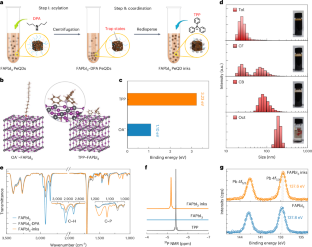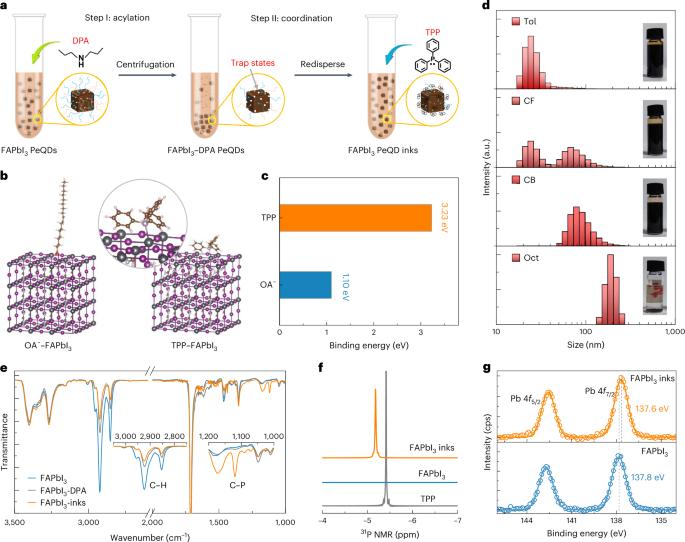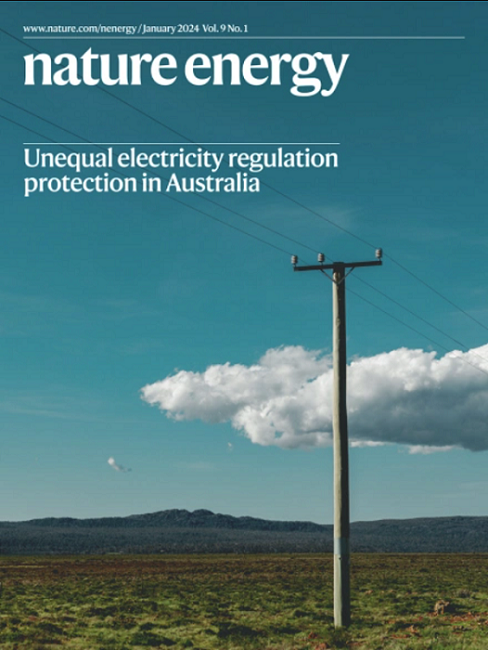Conductive colloidal perovskite quantum dot inks towards fast printing of solar cells
IF 49.7
1区 材料科学
Q1 ENERGY & FUELS
引用次数: 0
Abstract
Quantum dot (QD) provides a versatile platform for high-throughput processing of semiconductors for large-area optoelectronic applications. Unfortunately, the QD solar cell is hampered by the time-consuming layer-by-layer process, a major challenge in manufacturing printable devices. Here we demonstrate a sequential acylation-coordination protocol including amine-assisted ligand removal and Lewis base-coordinated surface restoration to synthesize conductive APbI3 (A = formamidinium (FA), Cs or methylammonium) colloidal perovskite QD (PeQD) inks that enable one-step PeQD film deposition without additional solid-state ligand exchange. The resultant PeQD film displays uniform morphology with elevated electronic coupling, more ordered structure and homogeneous energy landscape. Narrow-bandgap FAPbI3 PeQD-based solar cells achieve a champion efficiency of 16.61% (certified 16.20%), exceeding the values obtained with other QD inks and layer-by-layer processes. The conductive PeQD inks are compatible with large-area device (9 × 9 cm2) fabrication using the blade-coating technique with a speed up to 50 mm s−1. The manufacturing of perovskite quantum dot solar cells is hampered by time-consuming layer-by-layer processes. Zhang et al. demonstrate a method for preparing conductive quantum dot inks compatible with fast film printing.


实现太阳能电池快速印刷的导电胶体包覆晶量子点油墨
量子点(QD)为大面积光电应用的半导体高通量加工提供了一个多功能平台。遗憾的是,量子点太阳能电池受制于耗时的逐层制备工艺,这是制造可印刷器件的一大挑战。在这里,我们展示了一种顺序酰化配位协议,包括胺辅助配体去除和路易斯碱配位表面修复,以合成导电 APbI3(A = 甲脒 (FA)、铯或甲基铵)胶体包晶状 QD(PeQD)油墨,无需额外的固态配体交换即可实现一步式 PeQD 薄膜沉积。所制备的 PeQD 薄膜具有均匀的形貌、更高的电子耦合、更有序的结构和均匀的能量分布。基于 FAPbI3 PeQD 的窄带隙太阳能电池的冠军效率达到了 16.61%(认证值为 16.20%),超过了使用其他 QD 墨水和逐层工艺获得的数值。导电 PeQD 油墨可用于使用刀片涂层技术制造大面积器件(9 × 9 cm2),速度可达 50 mm s-1。
本文章由计算机程序翻译,如有差异,请以英文原文为准。
求助全文
约1分钟内获得全文
求助全文
来源期刊

Nature Energy
Energy-Energy Engineering and Power Technology
CiteScore
75.10
自引率
1.10%
发文量
193
期刊介绍:
Nature Energy is a monthly, online-only journal committed to showcasing the most impactful research on energy, covering everything from its generation and distribution to the societal implications of energy technologies and policies.
With a focus on exploring all facets of the ongoing energy discourse, Nature Energy delves into topics such as energy generation, storage, distribution, management, and the societal impacts of energy technologies and policies. Emphasizing studies that push the boundaries of knowledge and contribute to the development of next-generation solutions, the journal serves as a platform for the exchange of ideas among stakeholders at the forefront of the energy sector.
Maintaining the hallmark standards of the Nature brand, Nature Energy boasts a dedicated team of professional editors, a rigorous peer-review process, meticulous copy-editing and production, rapid publication times, and editorial independence.
In addition to original research articles, Nature Energy also publishes a range of content types, including Comments, Perspectives, Reviews, News & Views, Features, and Correspondence, covering a diverse array of disciplines relevant to the field of energy.
 求助内容:
求助内容: 应助结果提醒方式:
应助结果提醒方式:


